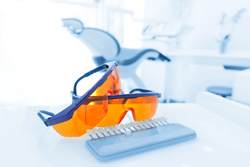
By Katherine Schrubbe
Eye protection for the patient is just as critical as for the provider. And, it’s important to remember that large group practices and DSOs can be role models for patient safety
Infection prevention and patient safety are essential to providing high-quality dental care. While most dental healthcare providers are educated about proper protocols and procedures around patient safety, many patients do not realize that protective eyewear can ensure their safety during what may appear to be a routine dental procedure. As Noam Chomsky says, “People not only don’t know what’s happening to them, they don’t even know that they don’t know.”
With the infrastructure to promote standards and guidelines and ensure they are followed, large group practices and DSOs are in a position to be industry role models.
From routine to nightmare
On July 8, 2013, Jennifer Morrone – a young mother of two daughters – visited her dentist for root canal therapy; the appointment quickly dissolved into a disaster. After giving Morrone an injection, her dentist made the mistake of passing the syringe over her face without first recapping the needle. Neither the dentist nor a member of his team had offered Jenn a pair of safety glasses.1,2
 “He dropped [the needle] directly in my eye,” reports Morrone. “The needle with the streptococcus bacteria punctured my eye, injecting the bacteria into it. I was not wearing eye protection.”2 To make matters worse, the dentist did not follow the protocol for an eye injury in the dental setting. Instead of leading Morrone to the eye wash station, he offered her a wet tissue and completed the root canal without addressing her injury.2
“He dropped [the needle] directly in my eye,” reports Morrone. “The needle with the streptococcus bacteria punctured my eye, injecting the bacteria into it. I was not wearing eye protection.”2 To make matters worse, the dentist did not follow the protocol for an eye injury in the dental setting. Instead of leading Morrone to the eye wash station, he offered her a wet tissue and completed the root canal without addressing her injury.2
This past June, at the OSAP Annual Conference in Atlanta, Ga., I had the opportunity to meet Ms. Morrone – a guest speaker at the conference – and hear her story firsthand. She told the audience that after she left the dental office, she went home, only to wake up the next day with excruciating eye pain. She went to the emergency room, where a team of doctors cleaned her eye and gave her antibiotics. In addition, she required steroids injected directly in her eye. But, nothing resolved the infection and she had to be admitted to the hospital for treatment. Morrone explained to the OSAP audience that the infection caused her retina to completely detach. After multiple fruitless surgeries, the doctors had to remove her eye lens. The story is heart-wrenching, and has affected her entire being, including her personal and professional life and those close to her. Her dentist’s poor practices and careless behavior led to a horrific patient injury, which could have been totally prevented with an inexpensive pair of protective eyewear.
Morrone is not the first dental patient to sustain an ocular injury at the dental office; there are many other similar cases. Even general dental treatment can generate spray and splatter, and the use of numerous instruments throughout treatment can pose a risk as well. For instance, a 2007 case report recounts the story of a female patient with contact lenses who was not wearing safety glasses during a dental appointment to have a bridge replaced. During the treatment, a stream of water was directed from the handpiece into her right eye. Because she suffered from subsequent pain in the eye, she consulted several ophthalmologists, who discovered inflammation and abrasive lesions on the cornea. Despite antibacterial and anti-inflammatory treatment, the patient’s visual acuity gradually declined over a period of several days. A microbiological examination nearly two months later revealed amoebae (Acanthamoeba spp) in corneal samples, which had caused a serious infection in the patient’s eye, leaving symptoms that persisted for years and later led to a lawsuit against the dentist.3
Clinician vs. patient
Clinicians appear to wear protective eyewear somewhat routinely. The same can’t be said for their patients. In a study of dental offices in the metro Detroit area, 75 participants responded to a survey, 61.3 percent of whom were hygienists; 36 percent dentists; and 2.66 percent dental assistants. Of the 75 survey participants, 61.3 percent had been practicing in the dental field for 20 or more years; 13.33 percent had worked in the field between 1-4 years; 12 percent had 15-20 years of experience; 9.33 percent had 5-10 years of experience; and 4 percent had 11-15 years of experience. When asked how often clinicians wore their safety glasses, 88 percent responded that they always wear them; 6.66 percent responded that they wear them most of the time; 6.66 percent responded that they wear them sometimes; and 0 percent said they never wear them. 4
When it came to patients’ use of protective eyewear, however, the responses differed greatly: 54.66 percent said they sometimes wear safety glasses; 20 percent said they never do so; 18.66 percent responded that they always do so; and 6.66 percent said they do so most of the time. At the same time, 10.66 percent of participants said their dental office has no safety glasses for patients to wear during dental procedures; 42.66 percent said their dental office has a few pairs for patients; and 46.66 percent said their dental office has many pairs available for patients.4
The Centers for Disease Control and Prevention (CDC) recommends eye protection for all dental patients.5 The Occupational Safety and Health Administration (OSHA) requires employers to provide protective eyewear or face shield protection for employees. This eyewear should be made of impact-resistant plastic in compliance with ANSI standards.6 Side protection must be included in the design of the protective eyewear and should not be removed; it should also be impact-resistant to deflect potential airborne debris – whether hard or soft – during procedures.7 One study found that the compliance rate for routine use of protective eyewear was only 60.3 percent for dentists and 34.1 percent for hygienists.8 Although OSHA is in place for the safety of all workers, including dental healthcare, shouldn’t we provide the same level of protection for our dental patients?
Empowering patients
Jenn Morrone is a vivid reminder of the importance of only one aspect of patient safety: eye protection. She has decided to turn her personal injury into a campaign to promote patient protective eyewear at dental visits. In spite of what she has endured, she has a positive attitude. To learn more, visit her Facebook page at www.Facebook.com/JennsVision (#JennsVisionSunglassSelfie) and view her YouTube video at www.youtube.com/watch?v=7r0jVgHx2do. In her live presentation, Jenn told the OSAP audience that she designated July 8, 2017, as the Annual Worldwide Day of Eye Protection Awareness at the Dentist.
Empowering patients to be their own advocates is one of the best things the dental team can do in infection control and prevention, and treating patients as part of the dental team will keep them safe.9 Clinicians should focus on the following:
- Educate patients about why they need eye protection. Empower them to ask for eye protection if the dental office forgets to offer it.
- Educate patients about why it is vital in fourhanded dentistry to never pass items over a patient’s face. Have them remind clinicians who do not follow this protocol how important it is to do so.
- Educate patients about recapping needles, and empower them to remind staff if the protocol is not followed.9
Eye protection for the patient is just as critical as for the provider. And, it’s important to remember that large group practices and DSOs can be role models for patient safety. Regardless of the practice setting, all clinicians must make patient safety a priority.
Editor’s Note: Katherine Schrubbe, RDH, BS, M.Ed, PhD, is director of quality assurance at Milwaukee, Wisc.-based Dental Associates.
References
- Picard C. A Mom Was Blinded After Her Dentist Didn’t Follow a Basic Guideline. Good Housekeeping; July 12, 2016. http://www.goodhousekeeping.com/health/news/a39366/woman-blinded-dentist/. Accessed July 26, 2017.
- Kelsch N. Jenn’s vision: A true lesson in best practices Dentistry IQ; August 1, 2014. http://www.dentistryiq.com/articles/2014/08/jenn-s-vision-a-true-lesson-in-best-practices.html. Accessed July 26, 2017.
- Barbeau J. Lawsuit against a dentist related to serious ocular infection possibly linked to water from a dental handpiece. J Can Dent Assoc. 2007; 73:618-22. http://www.cda-adc.ca/jcda/vol-73/issue-7/618.pdf. Accessed July 27, 2017.
- Oleksiak A, Campbell C, DiGiovanni A, Relich E. Ocular Incidents: Safety glasses prevent eye injuries among dental patients. RDH; May 11, 2015. http://www.rdhmag.com/articles/print/volume-35/issue-5/features/ocular-incidents.html. Accessed July 27, 2017.
- Guidelines for Infection Control in Dental Health-Care Settings — 2003. Centers for Disease Control and Prevention. December 19, 2003 / 52(RR17);1-61. https://www.cdc.gov/mmwr/preview/mmwrhtml/rr5217a1.htm. Accessed July 27, 2017.
- US Department of Labor; Occupational Safety and Health Administration. Personal Protective Equipment; 1910:133. https://www.osha.gov/pls/oshaweb/owadisp.show_document?p_table=STANDARDS&p_id=9778. Accessed July 27, 2017.
- American National Standards Institute (ANSI). ANSI/ISEA Z87.1-2015 Standard.
https://safetyequipment.org/isea-standards/ansiisea-z87-accredited-standards-committee/ansiisea-z87-1-2015-standard/. Accessed July 27, 2017.
- Shimoji S, Ishihama K, Yamada H, et al. Occupational safety among dental health-care workers. Adv Med Educ Pract. 2010;11: 41-7. https://www.ncbi.nlm.nih.gov/pmc/articles/PMC3643130/. Accessed July 27, 2017.
- Kelsch N. Jenn’s Vision. RDH; October 16, 2014. http://www.rdhmag.com/articles/print/volume-34/issue-10/features/jenn-s-vision.html. Accessed July 27, 2017.

